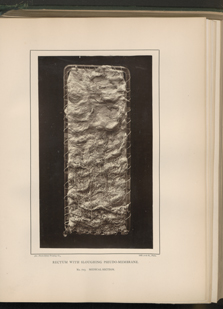Title: Brooks, William
Source text: The Medical and Surgical History of the War of the Rebellion. (1861-65.), Part 2, Volume 1 (Washington, DC: Government Printing Office, 1879), 446.
Civil War Washington ID: med.d1e41908
TEI/XML: med.d1e41908.xml
The sloughing which attacks the parts entangled in the diphtheritic exudation may be a gradual process, in which the necrosed tissue separates in little shreds; or portions of the surface of considerable size may be thrown off. The plate facing this page, which is a reproduction of a nature-size photograph of No. 703, Medical Section, illustrates one variety of the former of these processes. The following is a brief history of the case:
CASE 893.—Private Wm. Brooks, company H, 2d United States colored troops; enlisted March 11, 1865. From this time till December 31, 1863, he appears on the muster-rolls of his company as present for duty, except during September and October, when he was on detached service. With the exception of these two mouths he served in Florida, and was under treatment by the regimental surgeon in June for constipation, and in July and August for jaundice. About the middle of December he was taken sick with dysentery, and in January was sent north for treatment. He was admitted to Harewood hospital, Washington, D. C., January 12, 1866, having at that time been sick four weeks. He had the usual symptoms of acute dysentery, and died January 20th. Was not much emaciated at the time of death. The treatment consisted of astringents, opiates and supporting measures. Autopsy: The small intestine appeared to be quite normal. The colon was thickened and ulcerated in many places throughout. The rectum as in the specimen. The condition of the other organs is not recorded.—Surgeon R. B. Bontecou, U. S. V. [No. 703, Medical Section, Army Medical Museum, is from this case.]
The specimen represented by the plate is from the rectum of this patient. In the upper part of the piece the mucous and submucous tissues are swollen and infiltrated; the surface is irregularly coated with tough pseudomembrane. In the lower part of the piece the diseased coats are separating by sloughing, the sloughs adhering by one extremity and hanging down as string-like shreds, for the most part only a quarter to half an inch in length, but a few much longer. Higher up in the colon, it would appear from the report of the autopsy, the sloughs had completely separated in many places, leaving numerous ulcers.
